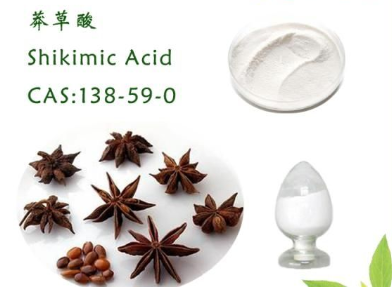Background and overview[1-2]
Shikimic acid is a cyclic organic acid found in natural plants such as star anise and some gymnosperms. It is the main active ingredient in the traditional Chinese medicine star anise, a plant in the Magnoliaceae family. Years of research have shown that it has thrombolytic, analgesic and anti-tumor effects. As an intermediate in chemical synthesis, shikimic acid is not only commonly used in analgesic, anticancer and antithrombotic drugs, but also in the synthesis of pesticides and antibacterial agents. With the widespread epidemic of avian influenza around the world in recent years, natural shikimic acid has become an essential raw material for the synthesis of Tamiflu, a highly curable human avian influenza virus. It has become very popular and its price has soared.
my country is the main production area of star anise in the world. More than 80% of the world’s star anise is produced in my country, which provides us with a rich and high-quality source of raw materials for extracting natural shikimic acid.

Extract[1]
1.500kg star anise dried fruit (shikimic acid content is 3.69%) is crushed to a particle size of 20 to 30 mesh and placed in a percolation tank. According to the material: water = 1:3 mass ratio, water is passed into the material. Heat the water temperature to 75°C under normal pressure and soak the material for 1 hour. Turn on the motor and cycle for 15 minutes. Then soak for 1 hour. Repeat this .5 times. After soaking and extracting for 7 hours, concentrate the percolate in the internal circulation concentration tank to obtain the specific gravity. The crude shikimic acid extract is 1.15 and weighs 45.7kg.
2. While hot, mix the shikimic acid crude extract according to the ratio of materials: silica gel = 1:1, stir evenly, cool to dry, and use it to load and inject through the chromatography column.
3. Place the cooled, dried and stirred silica gel samples on the top of six chromatography columns with an inner diameter of 40cm. The sample thickness is about 15cm, and then use a single component eluent – ethyl acetate. Elute the shikimic acid sample at the upper end of the chromatography column at a flow rate of approximately 800 ml/min.
4. Use a high-performance liquid phase detector to detect the outflowing eluent. When the eluent is detected to contain shikimic acid, the collection will begin. The collection will be completed after 5 hours. Special note: acetic acid was achieved during this process. Acetate pipeline, cycle operation. The conditions for detection of shikimic acid are mobile phase: double distilled water adjusted to pH 2 with phosphoric acid; flow rate: 0.6ml/min; wavelength: 213nm; column temperature 25°C; column C18; injection volume 20 microliters; control concentration 20 μg/ml.
5. Concentrate the collected liquid to dryness, add 15L methanol to dissolve, then add 45L water, let it stand and refrigerate for crystallization, filter the crystals the next day to obtain 18kg of pure dry shikimic acid, and the detected content is 92%.
6. Use the same crystallization method in step 5 to recrystallize once to obtain 16kg of fine shikimic acid with a content of 98%. The final extraction rate of shikimic acid is 85%.
Synthesis method[2]
A method for synthesizing shikimic acid, the method steps are as follows:
S1: Fructose 6-phosphate and glyceraldehyde 3-phosphate generate phosphoenolpyruvate and erythrose 4-phosphate under the catalysis of transketolase;
S2: DAHP synthase catalyzes phosphoenolpyruvate and erythrose-4-phosphate into 3-deoxy-D-arabino-hept-2-keto acid 7-phosphate and phosphate;
S3: 3-dehydrocolchicine synthase catalyzes the conversion of 3-deoxy-arabinoheptulonic acid 7-phosphate into 3-dehydroquinoline and phosphate;
S4: 3-dehydrocolchicine synthase catalyzes 3-dehydroquinoline into 3-anhydrocinoline and water;
S5: Shikimate dehydrogenase catalyzes 3-dehydrocinnoline into shikimate.
Apply[3]
3-dehydroshikimate compounds are a class of hydrogenated aromatic compounds (hydroaromatic intermediates) with important research value and application prospects. It is currently known that 3-dehydroshikimic acid (the hydrolyzate of 3-dehydroshikimate) is an important intermediate product in the biosynthetic metabolic pathway of aromatic amino acids in microorganisms and plants. It is important for maintaining normal development of organisms and completing metabolism. Process plays an important role. In recent years, studies have found that 3-dehydroshikimate compounds have superior antioxidant activity, and their activity is even better than gallic acid, propyl gallic acid, TBHQ, butylated hydroxytoluene and other commercial antioxidants, so they have potential commercial value. 3-dehydroshikimate compounds can also be used to prepare a series of valuable fine chemical products, including protocatechuic acid, vanillin, catechol, gallic acid, adipic acid and sialic acid, etc.
CN201010280085.5 reports a method for preparing 3-dehydroshikimate ester compounds, which includes the following steps: under the action of an acylating reagent, shikimic acid and alcohol undergo an esterification reaction to obtain shikimate ester compounds. , then, under the action of oxidizing agent, shikimate ester compounds are converted into 3-dehydroshikimate ester compounds.
References
[1][China invention, China invention authorization] CN200710021150.0 A production process of shikimic acid
[2][Chinese invention] CN201710298455.X A synthesis method of shikimic acid
[3][China invention, China invention authorization] CN201010280085.5 Preparation method of 3-dehydroshikimate compounds

 微信扫一扫打赏
微信扫一扫打赏

